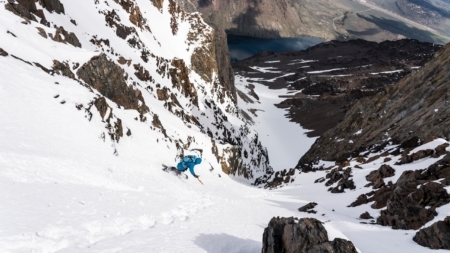Trying Adds Up
After years of dreaming, Nick Russell and Christian Pondella complete a clean descent on Mount Morrison in the Eastern Sierra.
I pull into the parking lot at the Convict Canyon trailhead around midnight. It’s May 29, 2019. The trees sway gently, and the sky is dark without a star in sight because of a thin veil of clouds. I stretch my legs after the three-and-a-half-hour time warp from Truckee, California. I’ve done this drive well over a dozen times this spring and it now goes by in a caffeine-induced blur of podcasts and mindsurfing the dark silhouettes of the Eastern Sierra front range. Winds are forecasted to dissipate by sunrise, but intermittent gusts say otherwise.
After organizing gear for the morning and getting my sleeping bag situated, I lie down to catch a few hours of rest. Nervous excitement is typical before a big day on a new line, yet for some reason I can’t shake a sense of foreboding. A strong believer in listening to gut instincts, I often wrestle with distinguishing legitimate concerns from unwarranted anxiety about serious undertakings in the mountains. I finally fall asleep, but somewhere between restlessness and lucid dreaming the voice of a young woman whispers to me, “Turn around.” My eyes open and I sit up to see my car shaking violently from side to side in a fury of wind. I eventually drift off, wondering if I should share my premonition with Pondella when we meet at the trailhead before sunrise.
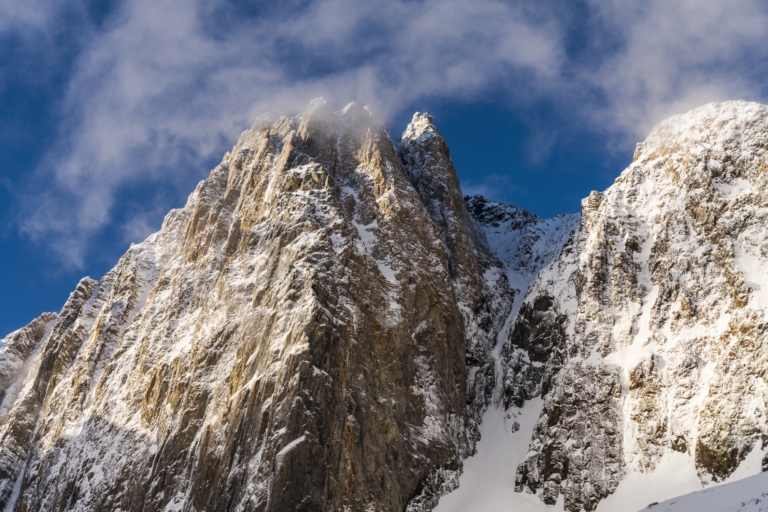
The Y-shaped line known as “Death Couloir” on Mount Morrison’s northeast face, icefall and all. There is no record of a first descent prior to Nick Russell and Christian Pondella’s completion. But Russell is wary of calling it a first, because “There is always a small chance that some rogue crusher in the ’90s did it solo.” Photo: Christian Pondella
Rising high above Convict Lake, Mount Morrison dominates the skyline and can be seen visibly from the highway outside of Mammoth Lakes. Records indicate that the peak was first climbed by either Norman Clyde or John Mendenhall in 1928, presumably via its eastern flanks. Its trademark characteristic is certainly the seemingly impenetrable northeast face, split by a steep, thin Y-shaped couloir ending in a large cliff. For anyone obsessed with dissecting fall line weaknesses, the line’s beauty is magnetic.
I’d passed by it many times, yet it took several years and the right mindset before viewing the line as a viable riding option; my aspirations always greater than my climbing ability. With no clue whether the route had been skied before, or if it was even possible, a phone call to photographer and Mammoth local Christian Pondella only intensified my curiosity. “Pondo” is an Eastern Sierra staple; his exploits and documentation of the range for the past two decades has inspired multiple generations. His response to my inquiry of the Y was matter-of-fact: “Oh yeah, the Death Couloir.”
Named for Morrison’s notoriously loose rock and poor protection, the only relatively safe way to gain the corridor is by a delicate alignment of the stars. A melt-freeze cycle is needed for the 200-foot rock pitch to ice over. But then one must also time that cycle just right due to the hangfire exposure of opposing southerly aspects that funnel into the gun-barrel of the couloir. Warming daytime melt-freeze temperatures could mean an avalanche that’d sweep us right out of the couloir, like a fleck of dust, off Morrison’s shoulder.
It is believed that Mendenall climbed the route just a few years after his initial foray on the mountain. Back in 1931, the crux pitch that currently shields the couloir from visitors is said to have been a connecting apron of snow. In modern times, and conditions likely similar to today’s, word is that Yvon Chouinard climbed the route in the ’70s, but the specifics are vague. An information scavenger hunt ultimately led me to the source: a phone call with Chouinard himself. While he’ll be the first to admit that his “memory isn’t worth shit anymore,” he confirmed his climb alongside Doug Robinson and another friend. Not only did they make a successful ascent, but they even had skis on their backs to descend off the backside of the mountain.
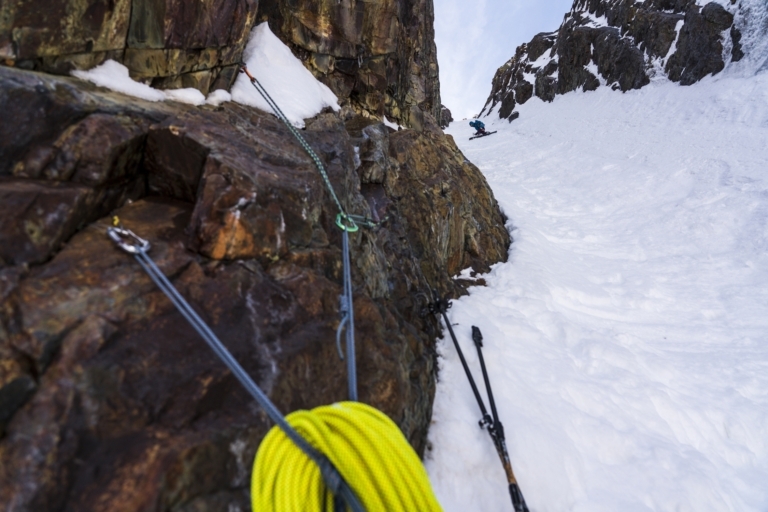
Nick Russell safely navigating into the crux of the descent, the steepest pitch of the line, directly above the rappel for the 200-foot icefall. Photo: Christian Pondella
At 5 a.m. after a sleepless night, Pondo meets me in the parking lot. The details of my premonition go unspoken, but the unrelenting winds make an easy decision for us to bail and get breakfast at Stellar Brew in Mammoth. Over brecky burritos and coffee, I learn that Pondo and Nathan Wallace, a friend and former climbing partner of Pondo’s, made a triumphant climb of the route in 1998 with the goal of skiing back down. But with inadequate gear for a rappel, the duo aborted the mission, and following Chouinard and co.’s lead, skied off the back. It’s also rumored the line was skied top-down sometime in the ’90s and climbed back out rather than descending over the crux. My growing infatuation and curiosity, along with Pondo’s unfinished business, means we won’t surrender without another solid attempt.
Two weeks later, we find ourselves back at the trailhead, moving well before the sun is awake. As we bushwhack up the thawed lower bench, an orange glow illuminates the jagged limbs of neighboring Laurel Mountain. Light but consistent snowfall over the past several days has coated the upper ridgelines, leaving a lingering taste of a bountiful season.
Skinning up the powdery apron, small spindrifts begin to trickle down the sheer rock faces, warning us to stay alert. The intensity and frequency of these loose, dry blasts of snow are closely monitored as we tuck ourselves in a rock alcove below the icefall pitch.
Both internal and verbal debates are settled as we tie into the rope and a roaring cloud of snow comes barreling over the top of us. The mountain isn’t going to let this happen.
I cling onto my board, which is shoved into the snow, so I’m not pulled down slope by the white cloud shrouding all visibility. We shouldn’t be here right now.
A swift escape to the safety of the opposing slope across the drainage provides the perfect vantage point to watch a massive pocket rip out, which surely would have taken us out had we made it into the couloir. Success is gratifying, but making the right call to back down validates decades of learning from the mountains. Maybe this isn’t meant to be. What if our ambitions are greater than the boundary of reasonable safety? Perhaps the line remains a forbidden fruit for good reason?
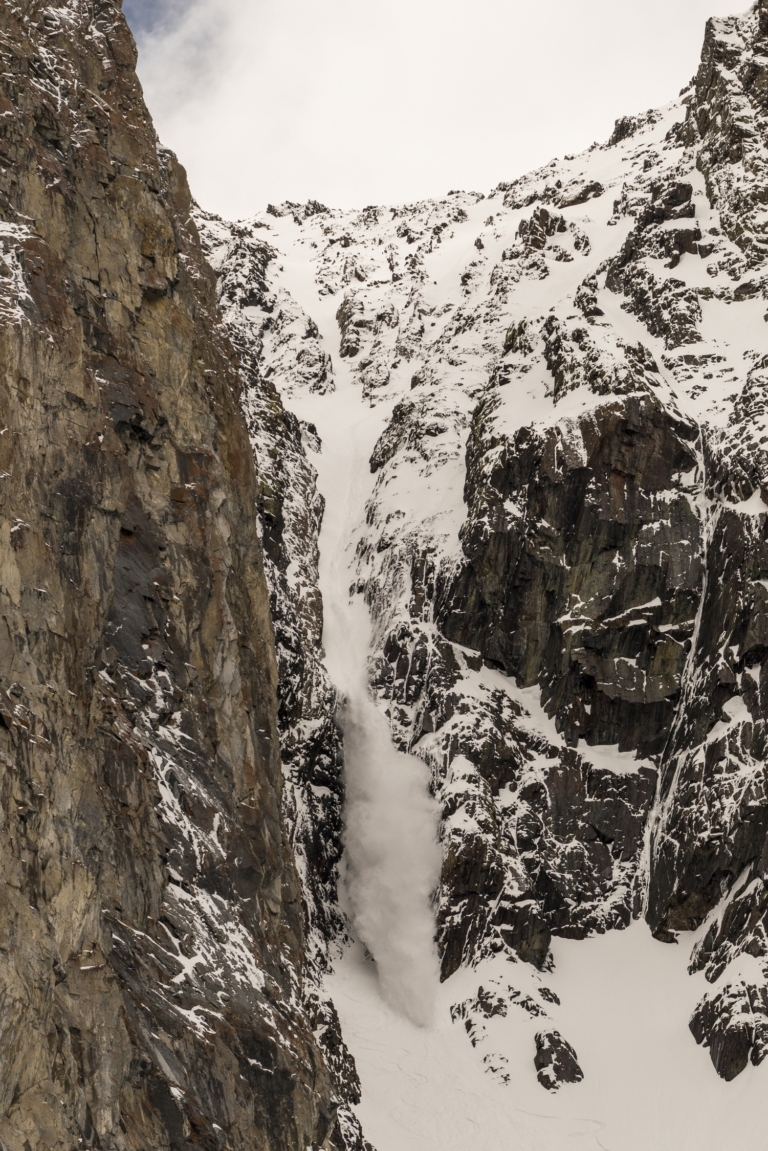
On their second attempt, and minutes after deciding to bail, the mountain comes crashing down. Photo: Christian Pondella
Winter slowly starts slipping through the cracks, as the days become warmer. Fishing season swoops in at Convict Lake and finding an adequate window of freezing temperatures at night seems unlikely. But the mountain presents a chance at redemption just three weeks after our initial attempt on the line. With the fresh snow now flushed out from above with the recent avalanche and a welcoming cloud protecting the face from the morning’s sun, we go through the motions. Pondo methodically leads the icefall, placing a handful of screws up the pitch for protection. He pulls up the slack in the rope and radios down to “climb quickly and efficiently.” I have only ice climbed once before in my life, and knowing that my friend is exposed, a hatch of butterflies explodes in my stomach. I clean the line and make it over the final bulge, and Pondo and I reconvene in the couloir proper with a hug. Understanding that the mountain is waking up with each minute, our blood doesn’t stop pumping until gaining the ridge.
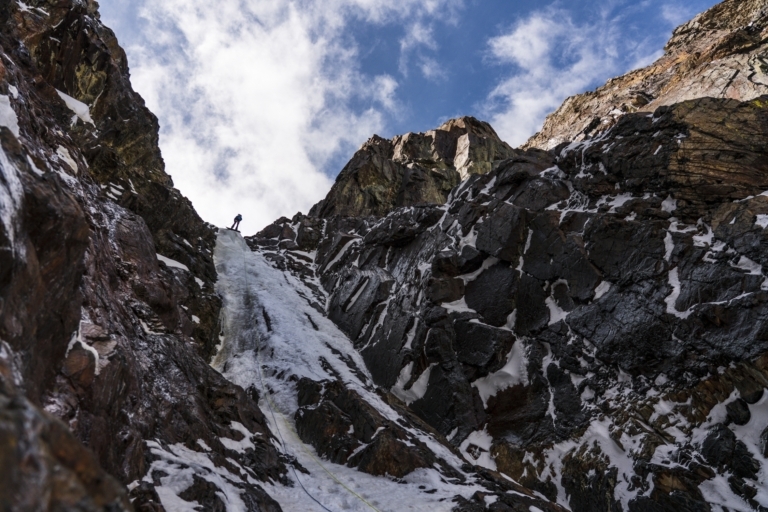
An icefall a day keeps the butterflies away, eh, or something like that. Nick Russell in the final 200-foot pitch of Mount Morrison’s Northeast Couloir. Photo: Christian Pondella
Strapping into my board as Pondo clicks into his skis, I share his joy that his 20-year pattern of getting shut down is about to come to an end. Nothing in life worth pursuing comes without struggle and self-doubt. There will always be elements beyond our control that dictate a route, but by learning to tap in and listen to the surroundings, as well our internal senses, we can safely navigate the hazards.
